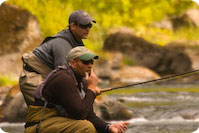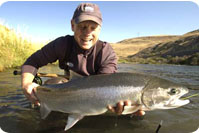Spey Page | Page Five
|
| Page 5 of 6 - 1 2 3 4 5 6 | |
Articles...
Sink-tip Grain Windows For Spey Rods
#10 Weight Rods: 255 grains to 165 grains
#9 Weight Rods: 220 grains to 130 grains
#8 Weight Rods: 190 grains to 100 grains
#7 Weight Rods: 140 grains to 80 grains
#6 Weight Rods: 110 grains to 60 grains
#5 Weight Rods: 90 grains to 50 grains |
Remember this is a general guideline! Every rod is different. We’ve seen some super-fast action #7 weights handle sink-tips in the #9 weight range. Not to mention caster ability. A really good caster might be able to cast ten feet of T-14 (140 grains) on a #6 weight rod. These windows are based on the average medium to medium-fast action rods and guiding experience. IE: What works best for the average steelhead angler.
Old Sink-tips… We all have them
Many folks have sink-tips from older generation Spey lines like Rio’s Windcutter or Airflo’s Delta Spey. Usually, they’re completely tangled up in some old shooting head wallet. They live in our gear bag but never get used. Guides love it when you ask if you can use them, especially when you have no clue what they are or where they came from. The good news is you can use these sink-tips -if they are the proper grain weight for your rod. You can weigh your old tips with a grain scale to determine their weight. However, many times it’s difficult to distinguish sink densities. As a general rule of thumb, the darker the color of the sink-tip, the faster it will sink. A dark gray sink-tip (usually type 6) will sink faster than a brown sink-tip. (Usually type 3)
Sink-tip Length
While sink-tip weight is extremely important, we cannot overlook length. There was a formula in the world of Skagit that said your total length of your Skagit head and sink-tip should be about 3 to 3 ½ times your rod length. Say what??? Not only did that formula confuse the hell out of the majority of anglers, it goes against the point of casting Skagit heads. In an effort to create a formula to standardize the length of Skagit heads, it made this way more complicated than it already is.
This isn’t rocket surgery people…
Sink-tip length is a matter of personal preference and casting style. An angler that stands 6’4” is going to cast very different than an angler that is 5’4”. The taller angler will naturally have a longer casting stroke. Consequently, they will probably like a little longer sink-tip, say 12’ to 15’. The shorter caster will more than likely gravitate towards shorter sink-tips in the 9’ to 12’ range. To add to the mix, casting style will effect how long your tips should be. Two different casters with the exact body type may cast completely different. One might have a long or “open” casting stroke, while the other has a very compact or “closed” casting stroke. The caster with the longer stroke will prefer longer sink-tips. Another factor to consider in sink-tip length is rod length. A 15’ Spey rod will handle much longer tips than a 12’ rod.
Before we complicate this anymore, lets make it simple… Most anglers casting a 12’6 to 14’ Spey rod feel very comfortable with a 12’ sink-tip. A 12’ sink-tip will cover the majority of fishing situations for both the West Coast and Great Lakes.
If you are hesitant to buy a brand new sink-tip and start whacking it apart with a scissors just because we said 12’ would work just fine, a good rule of thumb is to start by cutting your heaviest sink-tip to the length of your rod. Go to the river and cast it, see how it feels. Don’t use yarn because it’s easy to cast… Tie on a fly that you’ll actually fish for steelhead. You can always start at your rod length and cut back six inches at a time until you find the magic length for your stroke. It’s critical to start with your heaviest sink-tip. This formula came to us from steelhead guru Jeff Mischler –ex guide, producer of New Water Productions, and overall bad-ass steelhead angler.
Once you’ve found your preferred tip length with your heaviest sink-tip, then you can cut down your other tips to match the length and grain weight. Let’s say your heaviest sink-tip for your 13’6 for a #7 weight Spey rod is 12’ of Airflo CCT 200. At ten grains per foot, your heaviest tip is 120 grains. Your slower sinking tips should weigh no more than 120 grains, and no longer than the preferred length you found with the heaviest sink-tip. The slower sinking tips should be no lighter than about 95 grains. That gives you a “window” of 25 grains to work with. For your Type 6 sink-tip, you could start out with a 15’ Rio Type 6 for a #10 weight. Out of the package it weighs 150 grains. If we figure out the grains per foot, (150 divided by 15’) we get 10 grains per foot. If we cut our 15’ tip back to 12’, we remove 30 grains and get a sink-tip that weighs 120 grains. Know you have two different sink-rates at the same length and the same grain weight.
Ultimately, your goal is to end up with a set of sink-tips that fit your casting stroke and grain window of your rod. If you decide 12’ is your preferred length, all of your sink-tips should be around 12’. By having a consistent length and weight of sink-tips, your casting stroke won’t have to change every time you change your sink-tip. It is possible to cast different lengths of sink-tips, however, you will have to change your casting stroke as your sink-tip length changes. For strong Spey casters, changing lengths is not that difficult. However, beginner and intermediate anglers will really improve by having a consistent casting stroke.
| Page 6 of 6 - 1 2 3 4 5 6 | |
|
Free Shipping on orders $50.00 or more, and no sales tax in the USA.
|



